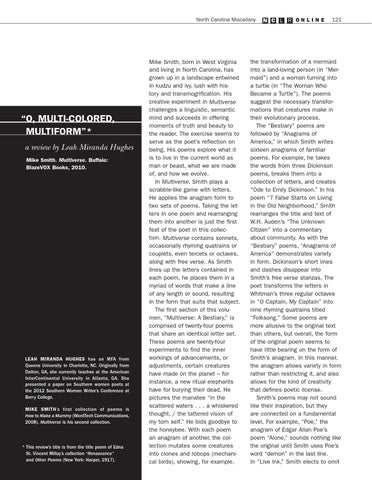North Carolina Miscellany
“O, Multi-Colored, Multiform”* a review by Leah Miranda Hughes Mike Smith. Multiverse. Buffalo: BlazeVOX Books, 2010.
Leah Miranda Hughes has an MFA from Queens University in Charlotte, NC. Originally from Dalton, GA, she currently teaches at the American InterContinental University in Atlanta, GA. She presented a paper on Southern women poets at the 2012 Southern Women Writer’s Conference at Berry College. Mike Smith’s first collection of poems is How to Make a Mummy (WordTech Communications, 2008). Multiverse is his second collection.
* This review’s title is from the title poem of Edna St. Vincent Millay’s collection “Renascence” and Other Poems (New York: Harper, 1917).
Mike Smith, born in West Virginia and living in North Carolina, has grown up in a landscape entwined in kudzu and ivy, lush with history and transmogrification. His creative experiment in Multiverse challenges a linguistic, semantic mind and succeeds in offering moments of truth and beauty to the reader. The exercise seems to serve as the poet’s reflection on being. His poems explore what it is to live in the current world as man or beast, what we are made of, and how we evolve. In Multiverse, Smith plays a scrabble-like game with letters. He applies the anagram form to two sets of poems. Taking the letters in one poem and rearranging them into another is just the first feat of the poet in this collection. Multiverse contains sonnets, occasionally rhyming quatrains or couplets, even tercets or octaves, along with free verse. As Smith lines up the letters contained in each poem, he places them in a myriad of words that make a line of any length or sound, resulting in the form that suits that subject. The first section of this volumen, “Multiverse: A Bestiary,” is comprised of twenty-four poems that share an identical letter set. These poems are twenty-four experiments to find the inner workings of advancements, or adjustments, certain creatures have made on the planet – for instance, a new ritual elephants have for burying their dead. He pictures the manatee “in the scattered waters . . . a whiskered thought, / the tattered vision of my torn self.” He bids goodbye to the honeybee. With each poem an anagram of another, the collection mutates some creatures into clones and robops (mechanical birds), showing, for example,
N C L R ONLINE
121
the transformation of a mermaid into a land-loving person (in “Mermaid”) and a woman turning into a turtle (in “The Woman Who Became a Turtle”). The poems suggest the necessary transformations that creatures make in their evolutionary process. The “Bestiary” poems are followed by “Anagrams of America,” in which Smith writes sixteen anagrams of familiar poems. For example, he takes the words from three Dickinson poems, breaks them into a collection of letters, and creates “Ode to Emily Dickinson.” In his poem “7 False Starts on Living in the Old Neighborhood,” Smith rearranges the title and text of W.H. Auden’s “The Unknown Citizen” into a commentary about community. As with the “Bestiary” poems, “Anagrams of America” demonstrates variety in form. Dickinson’s short lines and dashes disappear into Smith’s free verse stanzas. The poet transforms the letters in Whitman’s three regular octaves in “O Captain, My Captain” into nine rhyming quatrains titled “Folksong.” Some poems are more allusive to the original text than others, but overall, the form of the original poem seems to have little bearing on the form of Smith’s anagram. In this manner, the anagram allows variety in form rather than restricting it, and also allows for the kind of creativity that defines poetic license. Smith’s poems may not sound like their inspiration, but they are connected on a fundamental level. For example, “Poe,” the anagram of Edgar Allan Poe’s poem “Alone,” sounds nothing like the original until Smith uses Poe’s word “demon” in the last line. In “Live Ink,” Smith elects to omit
